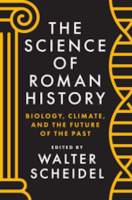
Princeton (2018) h/b 259pp £27 (ISBN 9780691162560)
Archaeology is still mostly about buckets and spades in the bottom of ditches in the pouring rain, recording what is found, preserving it and making sense of it. The most dramatic future developments are foreshadowed in this book: how we can wring more information out of what is dug up. The chapter headings give the clue, featuring archaeobotany (Marijke van der Veen), zooarchaeology (Michael MacKinnon), DNA (twice, Noreen Tuross and Michael Campana, Roy King and Peter Underhill), bones and teeth (Alessandra Sperduti, Luca Bandioli, Oliver Craig, Tracy Prowse and Peter Garnsey), and human growth and stature (Rebecca Gowland and Lauren Walther).
The first essay, however, builds on a book already published, Kyle Harper’s The Fate of Rome which argued that climate played a major role in Rome’s downfall (reviewed on this site here). Here Harper and Michael McCormick discuss the challenges of refining that thesis through greater understanding of the evidence offered by palaeoclimates and the human capacity for resilience as well as how this can be integrated with political, military and economic trends.
Your reviewer is not qualified to comment on the science behind the analyses, but it is made clear that work is proceeding at such a pace that what is state-of-the-art today is state-of-the-old-hat tomorrow, and caution is required when it comes to drawing historical conclusions. But here is a selection of findings to give some idea of the possibilities. The bigger picture has broad implications for our understanding of the whole of the ancient economy.
It is now possible to track the import of crops over long distances, raising questions about Roman economic development; improvements in diet over much of the population is evident across the empire (50 new plant foods in Britain), especially in the north-west (fruits, nuts, vegetables, herbs, spices and oil-rich seeds); and if one sixth of Pompeii’s surface was in fact given over to plant production, how densely were cities inhabited? Many of the same conclusions can be drawn from meat consumption during the imperial period. Animal species spread widely as plants; Nile fish were exported to Asia Minor; the migration of the plague carrying black rats can be tracked.
As for humans, bones and teeth provide vital evidence about health, morbidity and nutritional standards. Stable isotope analysis provides evidence of diet, dental analysis of weaning and sanitation in the young. As a result we can, for example, determine whether a person’s diet is fish or meat based; examination of the different layers that go to build up a child’s teeth can indicate when it moved from breast milk to solid foods. The mobility of humans can in principle be inferred from analysis of the different supplies of food and water the body has ingested, as does DNA analysis (also relevant to animals and crops). It had been thought that rabbits were introduced into Britain in the middle ages. Very recent work on a rabbit bone found in Britain has been dated to the first century AD, and its isotope signature showed that it ate its own faecal pellets. Since only rabbits in hutches do that, it was probably kept as a pet. Studies of remains from Romano-British York showed affinities mainly with British Celtic populations but also with those from Middle East.
Height usually equates with health; in the Roman period, heights tend to be lower than before or after (might this suggest a connection between the stresses resulting from the hierarchy of imperial rule and physical welfare?). Puberty seems to have been delayed compared with modern norms, males still developing in their twenties and females unable to reproduce till late teens. This did not apply to the better-fed élites.
Add all this to the more disciplined collation, preservation and storage of physical remains and keener awareness of the sort of information that they may contain, and there is no knowing where this brave new world of interdisciplinary archaeology may take us. This book make a superb introduction to the subject.
Peter Jones
